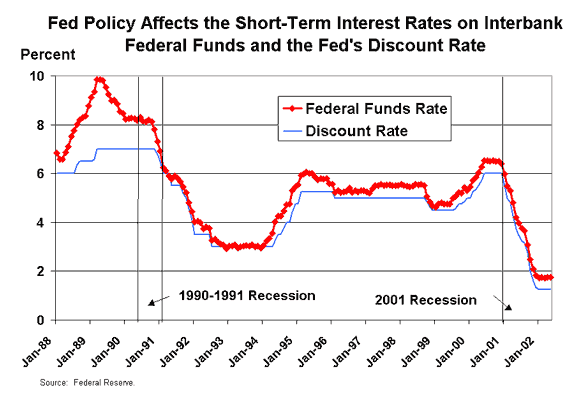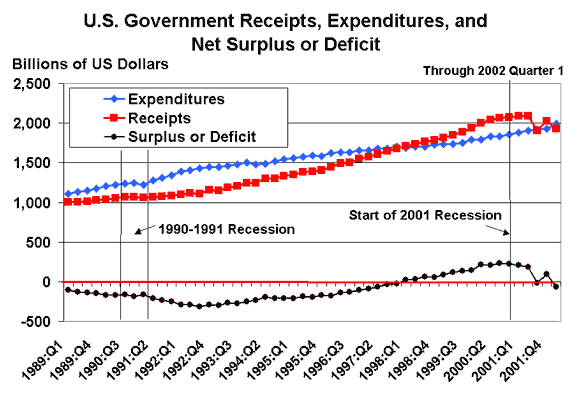Monetary policy is typically implemented by a central bank, while fiscal policy decisions are set by the national government. However, both monetary and fiscal policy may be used to influence the performance of the economy in the short run.
Basics
In general, a stimulative monetary policy is expected to improve the economy’s rate of growth of output (measured by Gross Domestic Product or GDP) in the quarters ahead; tight or restrictive monetary policy is designed to slow the economy in the future to offset inflationary pressures. Likewise, stimulative fiscal policies, tax cuts, and spending increases are normally expected to stimulate economic growth in the short run, while tax increases and spending cuts tend to slow the rate of future economic expansion.1
In 2001 the Federal Reserve made 11 reductions in the overnight interbank interest rate or federal funds rate—these actions were designed to stimulate growth in the face of a slowing economy.2 In contrast, in 1999 and 2000 when the economy was experiencing very rapid growth and a potentially unsustainable expansion without an increase in the rate of inflation, the Federal Reserve raised the federal funds rates in an effort to slow the overheated economy. (See Chart 1.)
Chart 1
Fiscal policy in 2001 also helped stimulate the slowing economy with a combination of tax cuts and spending increases. Spending increases take effect relatively quickly, while tax cuts may take several quarters to affect overall spending and output. (See Chart 2.)
Chart 2
Monetary Policy
Monetary policy’s impact on the economy is described in the Federal Reserve System’s Purposes and Functions publication.
The Federal Reserve Act lays out the goals of monetary policy. It specifies that, in conducting monetary policy, the Federal Reserve System and the Federal Open Market Committee should seek “to promote effectively the goals of maximum employment, stable prices, and moderate long-term interest rates.”
Using the tools of monetary policy, the Federal Reserve can affect the volume of money and credit and their price-interest rates. In this way, it influences employment, output, and the general level of prices.
The Federal Open Market Committee (FOMC), the Fed’s monetary policy-making body, issues a statement following each of its eight annual meetings. The statements describe economic conditions, monetary policy, and the actions the FOMC took with respect to the federal funds rate and the discount rate—the rate the Fed charges depository institutions for overnight borrowing . Those statements may be viewed on the Federal Reserve Board’s website.
For a general introduction to monetary policy issues, let me recommend the Federal Reserve Bank of San Francisco’s publication, U.S. Monetary Policy, an Introduction.
Fiscal policy
Samuelson and Nordhaus, in their text Economics (1998), define fiscal policy as follows:
A government’s program with respect to (1) the purchase of goods and services and spending on transfer payments, and (2) the amount and type of taxes.
Over the past year the U.S. budget has shifted from a surplus to a deficit, in part as a result of changes in fiscal policy. A combination of tax reductions, increased spending, and the 2001 recession caused the shift. The tax cuts and increased spending are part of the government’s fiscal policy that is designed to increase short-run economic growth. For an update on the state of the U.S. budget in 2002, please review the FRB SF Economic Letter by Carl E. Walsh titled, “The Changing Budget Picture.”
In addition, the Congressional Budget Office prepares a “Monthly Budget Review” that evaluates current tax receipts and spending outlays and compares estimated and actual budget figures.
Endnotes
1. Changes in monetary policy normally take effect on the economy with a lag of between three quarters and two years. The lag between a change in fiscal policy and its effect on output tends to be shorter than the lag for monetary policy, especially for spending changes that affect the economy more directly than tax changes.
2. Recessions are defined by the National Bureau of Economic Research. (http://www.nber.org)
References
“Monthly Budget Review.” Congressional Budget Office, U.S. Congress, available monthly, at http://www.cbo.gov/byclasscat.cfm?cat=35(May 23, 2002)
“Press Release” Federal Open Market Committee Statement, Board of Governors of the Federal Reserve System, at http://www.federalreserve.gov/FOMC/ (May 23, 2002)
Purposes and Functions. 1993. Board of Governors of the Federal Reserve System, Chapter 2. http://www.federalreserve.gov/pf/pf.htm(May 23, 2002)
“U.S. Monetary Policy: An Introduction.” 1999. Federal Reserve Bank of San Francisco, January. /publications/federalreserve/monetary/index.html (May 23, 2002)
Walsh, Carl E. 2002. “The Changing Budget Picture.” FRBSF Economic Letter, Federal Reserve Bank of San Francisco, 2002-08; March 22, 2002. /publications/economics/letter/2002/el2002-08.html (May 23, 2002)